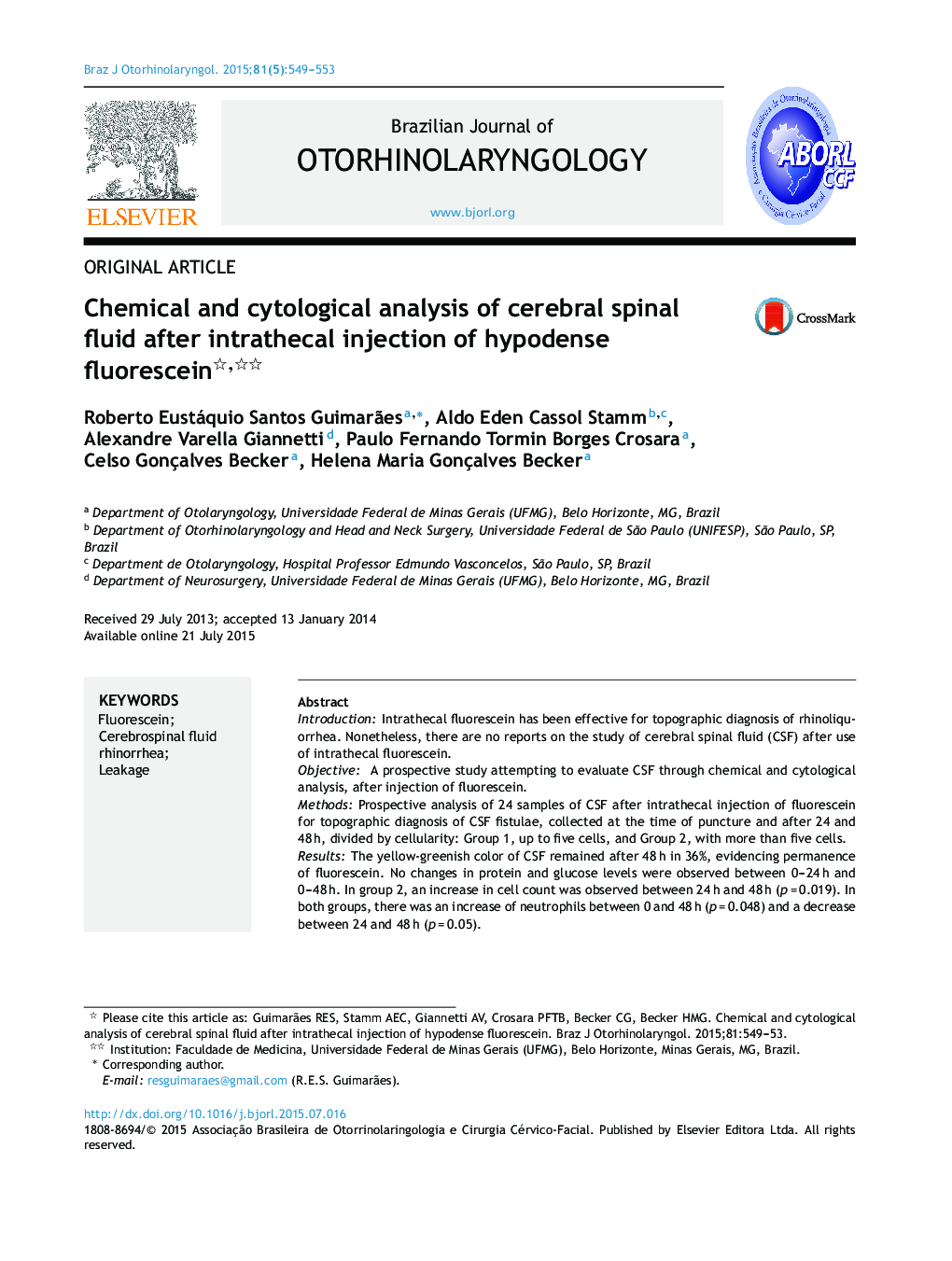| کد مقاله | کد نشریه | سال انتشار | مقاله انگلیسی | نسخه تمام متن |
|---|---|---|---|---|
| 4106177 | 1605365 | 2015 | 5 صفحه PDF | دانلود رایگان |

IntroductionIntrathecal fluorescein has been effective for topographic diagnosis of rhinoliquorrhea. Nonetheless, there are no reports on the study of cerebral spinal fluid (CSF) after use of intrathecal fluorescein.ObjectiveA prospective study attempting to evaluate CSF through chemical and cytological analysis, after injection of fluorescein.MethodsProspective analysis of 24 samples of CSF after intrathecal injection of fluorescein for topographic diagnosis of CSF fistulae, collected at the time of puncture and after 24 and 48 h, divided by cellularity: Group 1, up to five cells, and Group 2, with more than five cells.ResultsThe yellow-greenish color of CSF remained after 48 h in 36%, evidencing permanence of fluorescein. No changes in protein and glucose levels were observed between 0–24 h and 0–48 h. In group 2, an increase in cell count was observed between 24 h and 48 h (p = 0.019). In both groups, there was an increase of neutrophils between 0 and 48 h (p = 0.048) and a decrease between 24 and 48 h (p = 0.05).ConclusionIntrathecal fluorescein provoked discreet meningeal reactions, such as an increase of cells between 24 and 48 h and an increase of neutrophils at 24 h, with a subsequent decrease at 48 h with no correlation with symptomatology.
ResumoIntroduçãoA fluoresceína intratecal tem sido efetiva no diagnóstico topográfico da rinoliquorréia. Entretanto, não há estudos no líquor após o uso de fluoresceína intratecal.ObjetivoEstudo prospectivo visando avaliar o líquor, através de análise química e citológica, após injeção de fluoresceína.MétodoAnálise prospectiva de 24 punções após injeção intratecal de fluoresceína para diagnóstico topográfico de fístula liquórica, coletado no momento da punção, 24 e 48 horas, divididos pela celularidade: grupo 1, com até 5 células e grupo 2 com mais de 5 células.ResultadoA coloração amarelo-esverdeada do líquor permaneceu após 48 horas em 36%, evidenciando permanência de fluoresceína. Observou-se ausência de mudanças no nível de proteína e glicose entre 0–24 horas e 0–48 horas. No grupo 2, um aumento na contagem celular foi observado entre 24 e 48 horas (p = 0,019). No dois grupos juntos, observou-se um aumento de neutrófilos entre 0 e 48 horas (p = 0,048) e uma diminuição entre 24 e 28 horas (p = 0,05).ConclusãoFluoresceína intratecal provocou discretas reações meníngeas, como o aumento de células entre 24 e 48 horas e aumento dos neutrófilos em 24 horas com uma subsequente diminuição em 48 horas sem correlação com sintomas.
Journal: Brazilian Journal of Otorhinolaryngology - Volume 81, Issue 5, September–October 2015, Pages 549–553